SHOCK- 2015 All Coil (DHX RC4/RC2 & VAN R/RC)
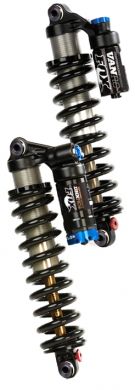
Travel
7.50 x 2.00
7.875 x 2.00
7.875 x 2.25
8.50 x 2.50
8.75 x 2.75
9.50 x 3.00
10.50 x 3.50
Features/Adjustments
Factory DHX RC4; Kashima Coated shaft, high-speed compression, low-speed compression, rebound, air assist, air assist volume, coil spring preload.
Performance DHX RC2; Anodized shaft, low-speed compression, rebound, air assist, coil spring preload.
Performance VAN RC; low-speed compression, rebound, coil spring preload.
Evolution VAN R; rebound, coil spring preload.
Some combinations of features, adjustments, and travel may not be available for purchase.
Spring
Coil
Riding style
All Mountain, Freeride, Downhill
Installing Your Shock
Check for clearance before riding.
If you are installing your shock on a bike for which the shock was not original equipment, follow the steps below to ensure proper clearance before riding.
- Remove the coil spring from your shock.
- Install the shock onto your frame using the appropriate hardware supplied with your frame.
- Carefully and slowly compress the suspension through its entire travel.
- Check that no part of your shock contacts any portion of your frame or linkage as it cycles through its travel.
- Remove the shock from your frame, reinstall the coil spring, and reinstall your shock to prepare to set sag as described in the "Setting Coil Spring Preload" section below.
Before You Ride
Make sure that your shock is ready to ride
- Clean the outside of your shock with mild soap and water and wipe dry with a soft rag.
- Do not use any solvents or de-greasers as these products can damage the shock's exterior finish.
- Do not use a high pressure washer or spray water directly at the seal/shock body junction.
- Inspect the exterior of your shock. The shock should not be used if any of the exterior parts appear to be damaged
- Contact your local FOX dealer or FOX directly for further inspection or repair.
- Make sure that your quick-release levers (or thru-axles) are properly adjusted and tightened.
- Check your headset adjustment. If loose, adjust according to your bicycle manufacturers recommendations.
- Check that all brake cables or hoses are properly fastened.
- Test the proper operation of your front and rear brakes on level ground.
Setting Coil Spring Preload
Sag should be set to 15 -€“ 20% of total shock travel
- Adjust your preload collar against your spring (clockwise) until your spring is retained tightly enough not to rattle, but has the minimum preload.
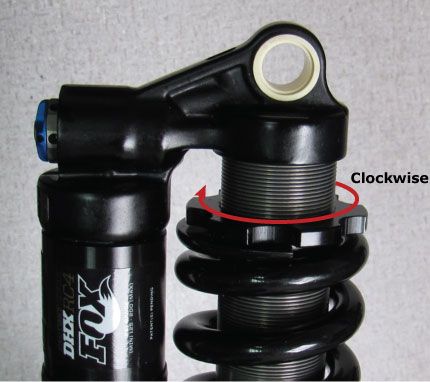
- Make sure your compression adjusters (RC4/RC2/Van RC models only) are set to their lightest settings (fully counter-clockwise)
- Dressed to ride (including a filled hydration pack, if you use one), position your bike next to a wall or table to support yourself. Mount your bicycle. Assume your riding position for at least 10 seconds, allowing the suspension to fully settle. Make sure you distribute your weight evenly between the saddle, handlebars and pedals.
- While in your riding position, have someone help you by measuring the distance from one shock eyelet to the other while sagging under your riding weight.
- Subtract your measurment of eyelet to eyelet distance while sagged in from your shocks uncompressed eyelet to eyelet length. This is your sag measurement. Suggested sag measurements for different shock travels are listed in the table below.
- If your sag measurement is less than desired when measured with the preload collar just tight enough against your spring to keep it from rattling loosely, you will need to swap your spring with one of a lighter spring rate.
- If your sag measurement is greater than desired when measured with the preload collar just tight enough against your spring to keep it from rattling loosely, turn the preload collar clockwise no more than 2 full turns to increase preload and decrease sag.
- If your sag measurement is greater than desired when measured with the preload collar already preloaded 2 full turns clockwise from the starting point when the collar is just tight enough against your spring to keep it from rattling loosely, you will need to swap your spring with one of a higher rate.
- Repeat steps 3-5 and recheck sag measurement.
| Suggested Sag Measurements | ||
| Shock Travel | 15% Sag (Firm) | 20% Sag (Plush) |
| 2.00 in./51mm | 0.30 in./7.6mm | 0.40 in./10.2mm |
| 2.25 in./57mm | 0.34 in./8.5mm | 0.45 in./11.4mm |
| 2.50 in./64mm | 0.40 in./9.6mm | 0.50 in./12.8mm |
| 2.75 in./70mm | 0.41 in./10.4mm | 0.55 in./14.0mm |
| 3.00 in./76mm | 0.45 in./11.4mm | 0.60 in./15.2mm |
| 3.50 in./89mm | 0.52 in./13.2mm | 0.70 in./17.8mm |
Changing springs
If necessary, changing coils can help you achieve proper sag.
- Loosen the preload ring until the spring freely moves.
- Lift up the spring and remove the spring retainer.
- Slide the spring off the shock body. Depending on your bike model, you may need to remove the reducers to remove the spring.
- Orient the new spring correctly (see Spring Orientation below) and slide it onto the shock body.
- Place the spring retainer back on the shock and under the spring ensuring that the open slot on the spring retainer rests on the flat part of the spring end.
- Tighten the preload ring just until the spring no longer moves.
- Turn the preload ring one additional full turn.

Adjusting Rebound
Rebound controls how fast the shock extends after compressing
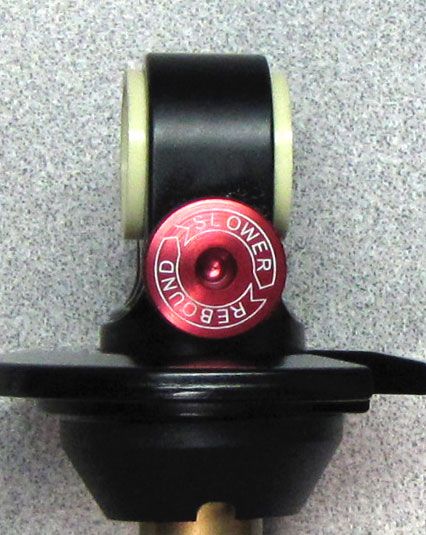
The red rebound knob is located on the shaft eyelet of coil shocks. Rebound controls the rate of speed at which the shock extends after compressing. Turning the red rebound knob clockwise (in) slows down rebound, turning the red rebound knob counter-clockwise (out) speeds up rebound. Rebound damping should only be set after first setting your air pressure by measuring sag.
- Make sure your compression adjusters are set to their lightest settings (both fully counter-clockwise).
- Starting with the rebound adjuster in the fully open position (counter-clockwise) push down on the saddle to compress the shock and feel its return speed.
- Increase rebound damping by turning the red rebound knob clockwise until when tested, the shock returns quickly but does not top out.
Top out is felt when a shock fully extends too quickly and comes to an abrupt stop when it reaches full extension (you will hear/feel a small noise). Top out should be avoided through proper rebound setting.
Using the High and Low Speed Compression Adjusters (DHX RC4/RC2)
LSC: (low speed compression)
Turn the blue LSC adjuster clockwise by hand, to increase low-speed compression damping. The LSC adjuster primarily affects the compression damping during slow speed suspension movements, such as pedaling, g-outs or smooth jump landings. It also affects the wheel traction and harshness (or plushness) of your bicycle. The LSC adjuster has ~18 clicks of adjustment range.
HSC: (high speed compression)
With a 2.5 mm hex key, you can adjust the silver HSC adjuster by inserting the hex key into one of the angled holes. Turn the HSC adjuster clockwise to increase, or counter-clockwise to decrease high-speed compression damping. The HSC adjuster mainly affects the compression damping during medium-to-fast suspension movements, such as steep jump faces, flat jump landings and square edge bumps. One of the best setups is to run with as little high-speed compression damping as possible, before (and without) bottoming. If you are bottoming out but like the way the shock is feeling, try reducing your Air-Assist volume before increasing your HSC. The HSC adjuster has ~12 clicks of adjustment range.
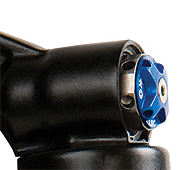
Using the DHX RC4 Air Assist
Use the Air Assist to fine tune spring rate and progression
Air Assist in the DHX RC2/RC4 shocks can help you fine tune your spring rate. You can adjust both Air Assit pressure and Air Assist rate.
- Air Assist pressure is used to help fine tune spring rates.
- Increase Air Assist pressure up to the maximum of 200psi to increase overall spring firmness.
- Decrease Air Assist pressure down to the minimum of 125psi to reduce overall spring firmness.
- Air Assist rate changes the progression of your spring rate.
- Decrease Air Assist volume by turning the blue Air Assist Rate knob clockwise to increase spring progressivity (ramp-up).
- Increase Air Assist volume by turning the blue Air Assist Rare knob counter-clockwise to reduce spring progressivity (more linear).
Always make sure that you have between 125-200psi after making any changes to Air Assist pressure or rate.
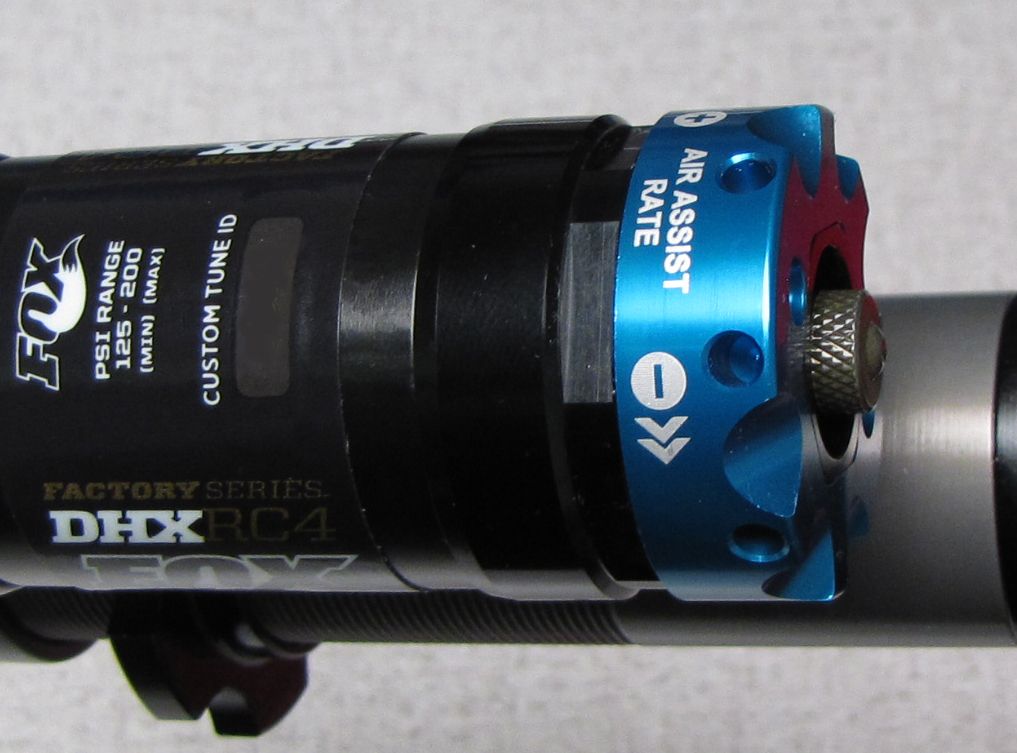
Adjusting Low-Speed Compression (Van RC only)
LSC: (Low-Speed Compression)
Turn the blue LSC adjuster clockwise by hand, to increase low-speed compression damping. The LSC adjuster primarily affects the compression damping during slow speed suspension movements, such as pedaling, g-outs or smooth jump landings. It also affects the wheel traction and harshness (or plushness) of your bicycle. The LSC adjuster has ~16-18 clicks of adjustment range.
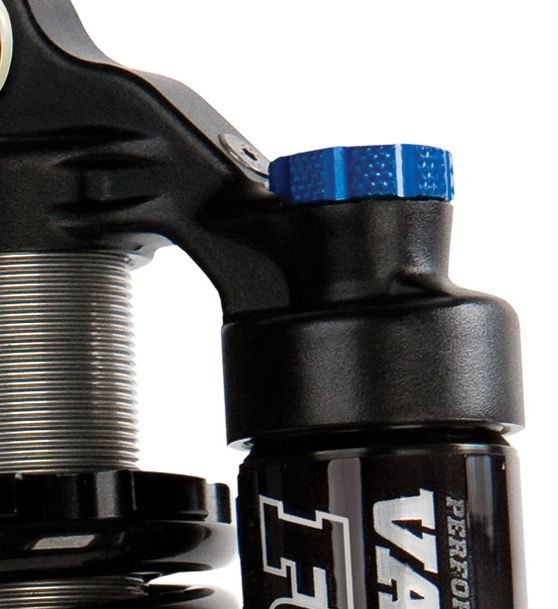
Service Intervals
To best maintain the performance and durability of your product under normal use, FOX recommends that you have regular fork and shock maintenance performed according to the service intervals listed below.

*Suspension product will require more frequent servicing the harder they are worked. For those who ride lift-accessed DH, Park, or Extreme Freeride or in extremely wet/muddy or dry/dusty environmental conditions where trail debris is sprayed onto the fork or shock while on the trail, or e-mtb's, FOX encourages riders to perform maintenance earlier than recommended above as needed. If you hear, see, or feel something unusual, stop riding immediately and contact a FOX Authorized Service Center for proper servicing.
